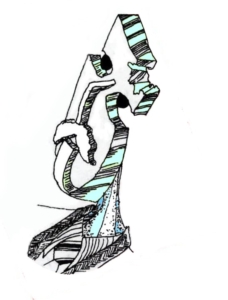Sound: [a]
Signifying:
- [a] scalar concept (magnitudinous concept as a phoneme) up, high, heights, sky
- [-a-] vectorial concept (directionally-relative-to concept as a morpheme) relative to heights
- (formally) the concept of erect-up main body
Graphic figure as a sign (icon)
The sound [a] in Türki is equal to the sound of [a] as in ‘bar’ in English.
This sound could be considered as one of the first four prominent stop sounds as found on the first phonetic alphabet of Ugarit (around 1400 BCE [3400 years ago]); then continued with Greek and Arabic alphabets. It is the first sound əlif on Ugarit alphabet. In fact, it is a complex consonant-vowel sound.
Here, we take some prominent and concrete form _the vowel [a]_ out of the complex alif.
Graphic shape of the sound [a] in Arabic alphabet (as an icon [primary level of signs] in semiotics) shows the same presumed signification with the sound ‘main body as standing vertically’:![]()
It has been written as əlif before. Better to keep it consistent or signal the change beforehand.![]()
We can check it on Greek alphabet, as the vertical figure:![]()
The vertical figure repeats with the following graphic shapes:
Check the signs at sound-signify sections of the sounds: B, Q, D
In fact, this graphic sign repeats with all the first four sounds on Ugarit phonetic alphabet.
The significance of the sound [a]
Vowels formed a topological system with early language.
Semiotically to say, vowels (as well as consonants) used to function as iconic significations, that is, as the simplest signs to convey/signify complex concepts/meanings. This complex concept or meaning refers to the topological position of each vowel.
To have some proper picture or understanding of the sound [a] we have to consider it on its topological position. To do so, we suppose the following black circle as ‘dir’ (the existence unit, being unit):![]()
This vowel sound [a] pairs with the vowel sound [ı]. We can see and check these pairing vowels with ‘dir’ as follows:![]()
Then, we can check the sound [a] on the model below:![]()
Finally, we can see and check the position of the sound [a] on the attractor model of vowels:![]()
